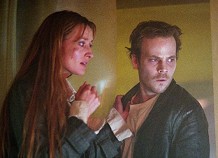![[Deep Focus]](../../flicker/longo.gif)

Don't open your browser.
![[Deep Focus]](../../flicker/longo.gif)
|
|
| FEARDOTCOM
|
|

|
F |
Don't open your browser. |
|
|
Movie Credits: Directed by William Malone Written by Josephine Coyle from a story by Moshe Diamant Cinematography by Christian Sebaldt Edited by Alan Strachan Starring Stephen Dorff, Natasha McElhone and Stephen Rea UK/Germany/Luxembourg, 2002 Aspect ratio: 2.35:1 (Super 35) Screened at Loews Palisades Center, West Nyack, NY |
Imagine that the Web draws energy, spiritual and otherwise, from the material world. Further imagine that if someone’s death were streamed over the Web, that person’s unquiet ghost could haunt the wires, going so far as to create an elaborate Flash-enabled site that kills everyone who visits it in precisely 48 hours — unless they manage to unravel the murder mystery. Spoooooooky. OK, this is not an unintriguing idea. In fact, it crosses the premises of two terrific Japanese horror films, Hideo Nakata’s chilling 1998 Ring (remade and ready for an October release by DreamWorks) and Kiyoshi Kurosawa’s grim Pulse, which debuted at Cannes last year. Pulse came out about the time this thing started shooting in Luxembourg, so maybe it’s just coincidence that both movies are about haunted Web sites. Director William Malone (1999’s House on Haunted Hill) is on the record denying any connection with Ring, although I have to wonder if producer Moshe Diamant (who takes credit for the story) could say the same thing with a straight face. The similarities between FEARDOTCOM and Ring are more than superficial. I can’t help but note that Diamant, who gave John Woo, Ringo Lam, and Tsui Hark their first Hollywood gigs, already has a history of co-opting Asian cinema. And if Malone — his bio over at filmdotcom.com describes him as a "film historian" — is really as ignorant of Ring, certainly one of only a handful of great horror movies in recent memory, as he claims, then perhaps someone should smack him upside the head. He deserves to make a movie as bad as this one. Certainly references to better genre films are abundant. The recurring presence of a little girl with a white ball seems to indicate a debt owed to Mario Bava, who used a similar figure in Kill, Baby, Kill (1968). The all-darkness-all-the-time visual style, urban setting, and themes of sin and punishment are direct descendants of David Fincher’s Se7en (1995). The notion of sadism as entertainment has been explored by David Cronenberg, whose old-school version of FEARDOTCOM was set in the world of cable TV and was called Videodrome. The torture sequences, in which Dr. Alistair Pratt slices the clothing off of pretty young women and promises to kill them once the pain becomes too much for them, would echo the beautiful cruelty of Dario Argento if they had any snap. Instead, they’re redolent of junk like The Cell, in which nude corpses become fetish objects to augment a flamboyantly grisly visual style. As Fincher proved, the Grand Guignol strategy can pay off big if your movie has a philosophy that demands that sort of treatment, but this one is just lazy. The big mystery is how Malone convinces name casts to appear in his semi-competent fare. House on Haunted Hill was carried, more or less, by the charismatic presence of good-looking and/or talented folks like Geoffrey Rush, Famke Janssen and Taye Diggs. FEARDOTCOM’s most prestigious star is probably Stephen Rea. If you wonder what he’s doing here, consider the strange case of the far more genre-friendly Udo Kier and Jeffrey Combs, both of whom appear early on only to be wasted in victim roles. Compared to those guys, Stephen Dorff and Natasha McElhone are bland-o-rama, so why do they get all the screen time? To be fair, I didn’t hate everything about this movie. The occasional sequences when the ho-hum narrative drops completely away to be replaced by a stream of dreamy visuals are at least stimulating in a purely visual sense (again the Argento connection). And while one of the more tedious plot devices has to do with the victims of feardotcom.com being killed by manifestations of their own greatest phobias, it does lead to one of an entertainingly gross scene in which a woman and her apartment are overrun by Madagascar hissing cockroaches. (Of course this same idea was already explored to more extreme effect in a movie called Creepshow, but never mind.) And toward the very end of the picture, Malone seems to engage in a weird sort of auto-critique. When bad guy Alistair Pratt (Rea) finally meets his end, he is seen in a scratchy-celluloid environment where the victims of his heinous crimes come back to get him — so Stephen Rea’s greatest fear is being stuck in a bad horror movie! Ha! Gotcha, Steve. |
 http://www.deep-focus.com/flicker/
bryant@deep-focus.com
http://www.deep-focus.com/flicker/
bryant@deep-focus.com